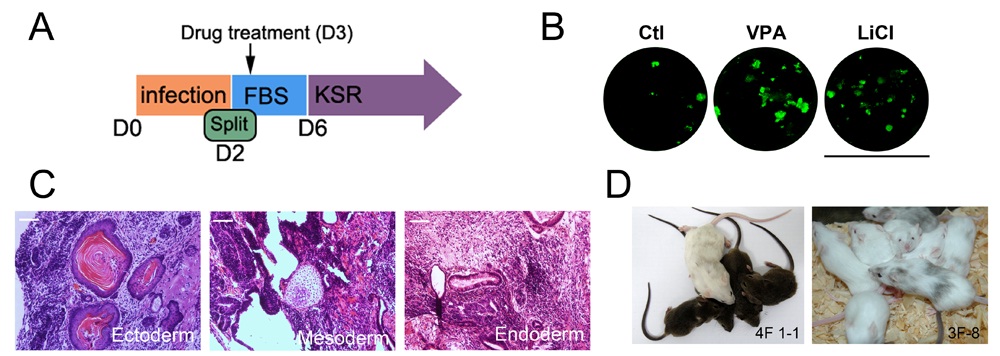
Embryonic stem cells (ESCs) could potentially revolutionize medicine by providing an unlimited renewable source of cells capable of replacing or repairing damaged tissues in almost all degenerative diseases. Recent works demonstrated that ectopic expression of defined transcription factors (Oct4, Sox2, Klf4, c-Myc and et al) could reprogram murine and human somatic cells to induced pluripotent stem cells (iPSCs). The iPSC technology has attracted enormous interests due to its potential biomedical applications. Patient-specific iPSCs could be created by reprogramming and they could be further differentiated into functional autologous cells for cell-based therapy without immuno-compatibility issues and ethical concerns. However, iPS cell applications are hindered by safety concerns due to the use of oncogenes and incorporation of viral DNA sequences. Many efforts have been taken to make iPSCs more amenable for therapeutic application.
Graduate students WANG Quan and XU Xinxiu from Dr. XIE Xin’s group in Shanghai Institute of Materia Medica (SIMM) discovered that LiCl, a drug used to treat mood disorders, greatly enhances iPSC generation from both MEF and HUVEC. Li facilitates iPSCs generation with one (Oct4) or two factors (OS or OK). The effect of Li on promoting reprogramming only partially depends on its major target GSK3b. Unlike other GSK3b inhibitors, Li not only increases the expression of Nanog, it also enhances the transcriptional activity of Nanog. Li was also found to exert its effect by promoting epigenetic modifications via downregulation of LSD1, a H3K4 specific histone demethylase. These results not only provide a straightforward method to improve the iPSC generation efficiency, but also identified a histone demethylase as critical modulator for somatic cell reprogramming. On July 5, 2011, this new discovery in small molecule-enhanced reprogramming was published online by Cell Research.
This work was supported by grants from Chinese Academy of Sciences and Chinese Minister of Science and Technology.
Original article: http://www.nature.com/cr/journal/vaop/ncurrent/pdf/cr2011108a.pdf

A. Schematic representation of iPSC protocol with chemicals; B. Representative images of GFP+ colonies in 96-well plates; C. HE-stained sections of teratomas formed with clone 4F 1-1; D. Left: a chimeric mouse produced with iPSC clone 4F 1-1 and its agouti coat colored offspring. Right: chimeric mice produced with iPSC clone 3F-8.(Image by SIMM)

86-10-68597521 (day)
86-10-68597289 (night)

86-10-68511095 (day)
86-10-68512458 (night)

cas_en@cas.cn

52 Sanlihe Rd., Xicheng District,
Beijing, China (100864)

